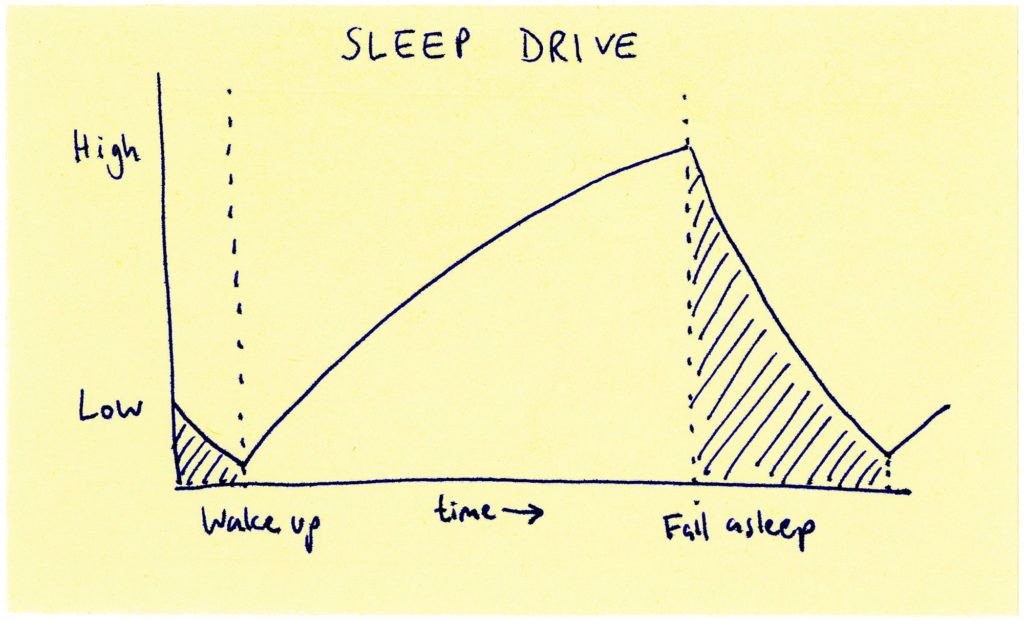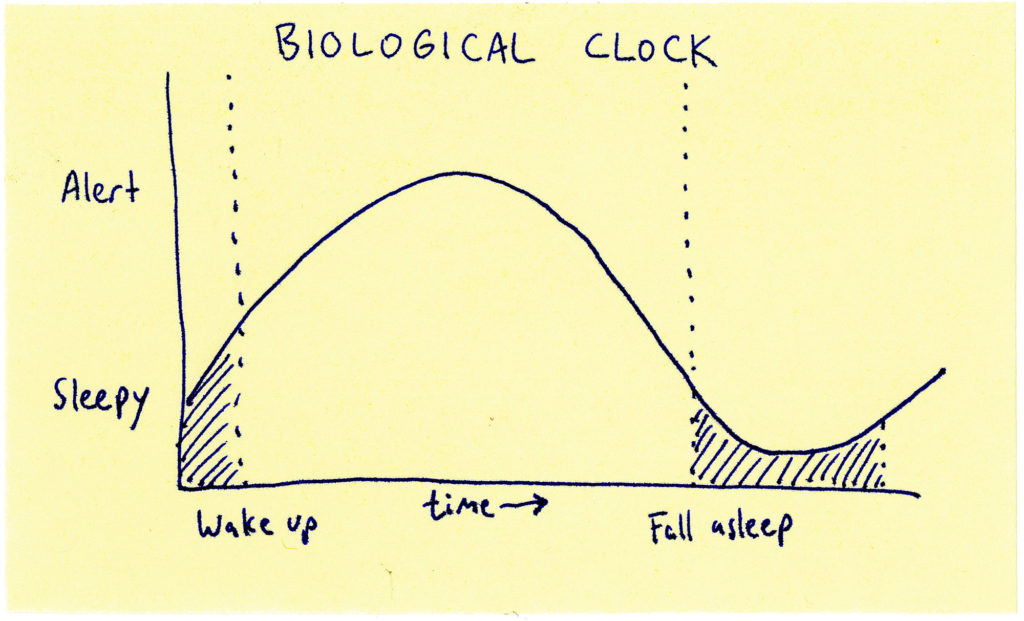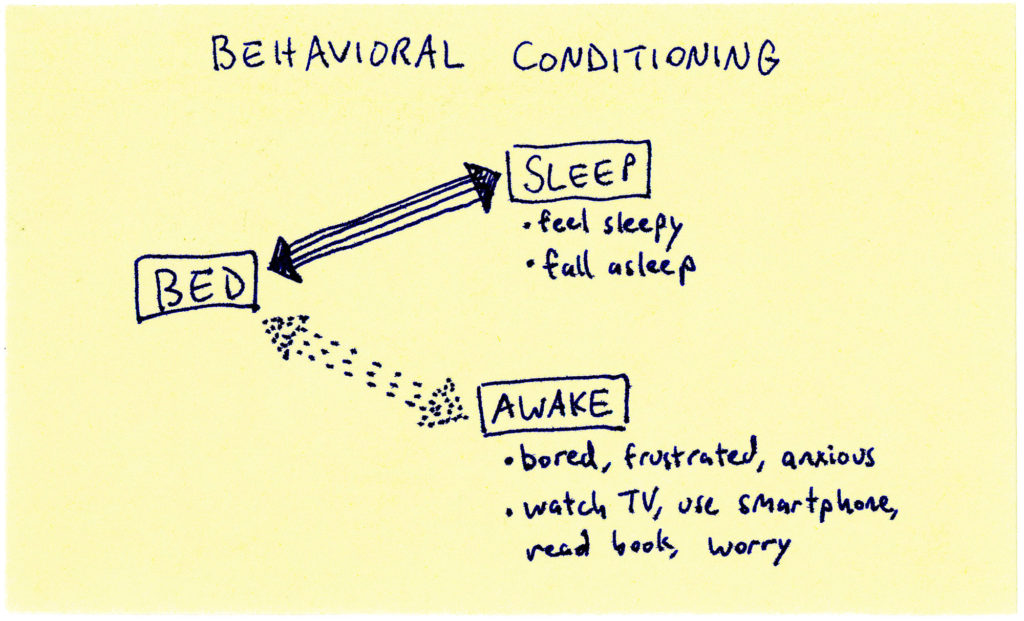
– How to Fix Insomnia –
2: Understanding How Sleep Works
In this section, we cover the three most important “systems” to target using behavior changes, in order to most effectively improve your sleep. The first two are the primary biological processes that regulate the body’s sleep/wake cycle, and the third is a behavioral phenomenon. Obviously, there is a whole lot more to the biological complexities of sleep that we won’t be able to cover here – and if you’re interested, I’d highly recommend learning more about this fascinating subject – but I think improving your sleep is most effective when you start with a solid grasp of these following systems. I try hard to make this information relevant and succinct, so please try not to yawn or skim through it (although I’ve had more than a few people doze off during this content during my sleep classes…).
Sleep Drive
Formally known as the homeostatic sleep drive, this first system is pretty easy to conceptualize.1 The sleep drive is the body’s internal drive, or pressure, or propensity, towards sleep. Basically, the longer you’ve been awake, the higher your sleep drive will be, which means the more likely you will feel sleepy and the more likely you will fall asleep. Think about hunger as an analogy: the longer you haven’t eaten, the hungrier you’ll feel and the more likely you are to seek food. The graph below illustrates how sleep drive builds while you are awake and decreases while you are sleeping.

If you’ll indulge me for a moment in some fascinating brain science, there is actually a “neuromodulator” molecule that builds up in your brain every moment you’re awake (a byproduct of energy use) and gets “burned off” while you sleep. This molecule, called adenosine, is a critical part of a feedback loop in the brain that controls sleep drive. This means that sleep drive accumulates in your brain in a very real sense! By the way, did you know that the active ingredient in our favorite morning beverage makes us feel perky by disrupting the sleep drive feedback loop (due to being an adenosine antagonist, or blocker)?2
Biological Clock
Also known as our circadian rhythms, the biological clock is the way our body internally keeps time and rhythmically regulates many different biological functions.3 So, not just sleep-wake behaviors, but also body temperature, hormone production, hunger, urine/bowel movements, and more, are regulated according to a roughly 24-hour internal clock. For our purposes, we are most interested in how the sleep-wake cycle is regulated. The biological clock tells our bodies (primarily by sending “alerting signals”) when to be alert and when it’s okay to be sleepy.
If you’ve ever pulled an all-nighter, you know that there comes a point in the wee hours of the night, maybe somewhere between 3 to 5 am, when you’re no longer getting sleepier and sleepier as it gets later, but you’re instead becoming more awake and alert. Even though your sleep drive is continuing to build, something internally is overriding that and causing you to feel more awake. This is the biological clock and the alerting signals on display. You might be more of a night owl or a morning person based on genetic predisposition, but you can shift your biological clock forward or backward using behaviors. And you can also use behaviors to either confuse your biological clock and throw it out of whack, or to cause your biological clock to reliably tell you when to get sleepy and alert.

Lastly, I’d be remiss not to briefly mention melatonin and light exposure: melatonin is a “darkness signaling hormone” (not a sleep aid!) that our brain produces in the evenings as the sun goes down. This is one way our biological clock keeps in sync with nature’s 24-hour cycle – and this is also a way that our digital technology (light-emitting screens) disrupts our circadian rhythms and delays sleepiness.4
Behavioral Conditioning
Have you ever been so tired in the afternoon and throughout the evening that you’re struggling to stay awake behind the wheel on your commute home, nodding off while talking to your family, dozing off while on the couch watching TV, and then the moment you get into your bed and hit the pillow, BAM, you’re wide awake and it’s going to take you an hour or more to actually fall asleep? The majority of my insomnia clients have told me some version of that scenario, and for many, this is a daily/nightly occurrence. What is going on? Well, this is a classic example of a phenomenon called behavioral conditioning. Through months or years of reinforcement, the bed has actually become a trigger for being unable to fall asleep. The very act of getting into bed elicits wakefulness, frustration, boredom, and/or racing thoughts, and causes difficulty falling asleep even though you may have been very sleepy just moments before.

How did this happen? For starters, people with insomnia are, by definition, having difficulty falling asleep and/or staying asleep, so they’re probably spending a lot of time in bed awake and not asleep. In addition, “helpful” coping behaviors like trying to get more sleep by getting into bed earlier, taking naps, or sleeping in, typically add to the problem by increasing the amount of time they spend in bed not asleep. Finally, other coping behaviors such as reading, watching TV, and using smartphones in bed further reinforce wakeful behaviors in bed. In essence, each time you participate in any non-sleep activity in bed, you are weakening the bond between bed and sleep, and strengthening the bond between bed and being awake. You can imagine why months or years of reinforcing this would cause the act of getting into bed to elicit an automatic conditioned response of wakefulness. Our goal is actually for the opposite to happen, through behavioral conditioning. Our goal is that when you get into bed, you suddenly become even more sleepy and drift off into sleep. It may sound highly unlikely to you, especially if you’ve had years of sleep problems, but you can really train your body and brain to get to this point (and in a relatively short period of time)!
Summary
Here’s a quick recap, in case your eyes glazed over or you fell asleep, of the three most important “systems” we want to target:
- Sleep drive: The longer you stay awake, the higher your sleep drive. You need a high sleep drive to fall asleep. Our goal: consistently high sleep drive each night.
- Biological clock: Determines periods of sleepiness and alertness over the 24-hour cycle. Our goal: strengthen the biological clock to make it consistent and in sync with your schedule.
- Behavioral conditioning: Repeated reinforcement of behavior causes a stimulus (the bed) to trigger an automatic conditioned response (wakefulness). Our goal: use behavioral conditioning to pair the bed with sleepiness instead.
Next, we will learn about how best to target these systems.
- Homeostatic sleep drive and internal clock: http://healthysleep.med.harvard.edu/…
- Caffeine and adenosine illustration: http://thebrain.mcgill.ca/…
- Circadian body clock: https://sleepfoundation.org/…
- Blue light has a dark side: http://www.health.harvard.edu/…